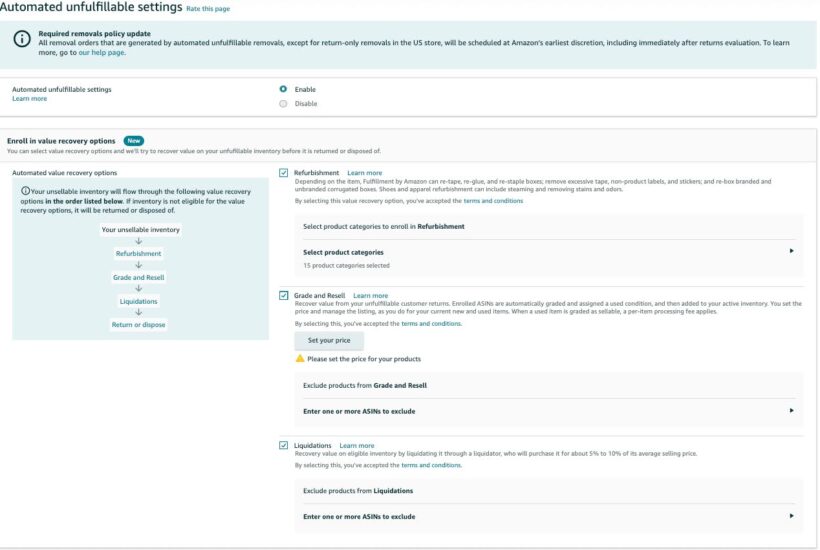Table of Contents
Mastering Amazon Returns: A Strategic Approach to Growth
Returns are an inevitable part of selling on Amazon, but with the right strategies, they can be managed in a way that minimizes negative impact, strengthens customer relationships, and even improves profitability.
Instead of viewing returns as a setback, sellers should see them as an opportunity to refine operations, enhance product quality, and build long-term trust. Here’s a comprehensive guide to managing Amazon returns strategically.
Understanding Amazon’s Return Landscape
Amazon’s return process varies depending on whether you use Fulfilled by Amazon (FBA) or Fulfilled by Merchant (FBM). With FBA, Amazon takes full control of returns and refunds, simplifying the process for sellers but charging fees for the service.
In contrast, FBM sellers handle returns independently, offering them greater control over customer interactions and resolutions. Most products fall under Amazon’s standard 30-day return policy, which can extend during peak shopping periods.
Understanding these policies is crucial, but just as important is tracking return reasons. A surge in “Defective” returns, for example, can trigger listing suspensions or even impact seller account health. Proactively monitoring returns through Seller Central > Reports > Fulfillment > FBA Customer Returns helps sellers identify patterns and address potential issues before they escalate.
Preventing Returns: Setting the Right Expectations
A significant portion of returns stems from misaligned customer expectations. High-quality imagery that accurately represents the product, detailed descriptions that leave no room for ambiguity, and A+ Content that addresses common customer concerns can drastically reduce unnecessary returns.
Additionally, proactive product testing is essential by identifying potential defects before launching a product, sellers can prevent quality issues that lead to dissatisfied customers. Integrating customer feedback into product development is another key factor; regularly reviewing feedback and return data helps pinpoint recurring issues, allowing for targeted improvements that reduce return rates over time.
Investing in Resilient Packaging
Packaging plays a critical role in preventing transit-related returns. Using durable materials to protect products from damage, adding proper labeling such as “Fragile” or “This Side Up,” and ensuring secure sealing can significantly reduce returns caused by shipping mishaps.
If a product frequently returns due to similar issues, sellers should investigate and resolve the core problem rather than simply processing each return as a one-off event.
Strengthening packaging isn’t just about avoiding damaged goods, it’s also about reinforcing the perception of quality and reliability in the customer’s mind.
Professional Return Management: Protecting Your Metrics
Effectively managing returns goes beyond just handling refund requests. Regular monitoring of return trends through Seller Central > Reports > Fulfillment > FBA Returns can provide insights into which products or categories are most affected.
Enabling automation features like restocking undamaged returned merchandise helps maximize inventory efficiency. However, if returned products are no longer sellable due to damage, sellers should request reimbursement from Amazon to recover potential losses. Alternatively, Amazon also offers automated revenue recovery features, like Refurbishment, Grade & Resell, Liquidations and Donations.

Finally, fast and clear communication is crucial, addressing return requests within 24 hours aligns with Amazon’s service benchmarks and improves customer satisfaction. In some cases, offering replacements instead of refunds can help retain revenue while resolving the customer’s issue.
Turning Returns into Opportunities for Customer Loyalty
Handled correctly, returns can actually strengthen customer relationships. A simple, courteous post-return email acknowledging the customer’s experience can turn a negative situation into a positive one.
Offering a small discount or incentive on their next purchase encourages repeat business, helping to offset the impact of a return. If a customer had a smooth return experience, inviting them to leave a review can still generate positive feedback, reinforcing brand credibility.
By maintaining an open line of communication and focusing on customer satisfaction even after a return, sellers can turn a refunded transaction into a long-term customer.
Analyzing Returns to Reduce Future Issues
Data is one of the most powerful tools in minimizing returns. By leveraging detailed return reports in Seller Central, sellers can analyze patterns and adjust product descriptions, images, or packaging accordingly. If a specific reason for returns keeps appearing—such as “item not as described” or “size too small”—fine-tuning listings to better match customer expectations can significantly reduce return rates.
Additionally, understanding category-specific return rates is important; apparel generally experiences higher returns than electronics due to sizing issues, so setting expectations accordingly can mitigate unnecessary returns.
Conclusion: Transforming Returns into Revenue
Returns are an unavoidable part of selling on Amazon, but they don’t have to be a liability. By refining listings, improving quality control, strengthening packaging, and managing returns efficiently, businesses can turn these challenges into growth opportunities.
A well-handled return can increase customer trust, improve brand reputation, and even lead to repeat purchases. Instead of viewing returns as losses, sellers who take a proactive approach can use them to drive long-term success.
Looking for expert guidance? Adverio specializes in optimizing Amazon operations, helping sellers streamline processes, reduce returns, and boost profitability. Take the next step in turning your Amazon returns into a competitive advantage today!





























